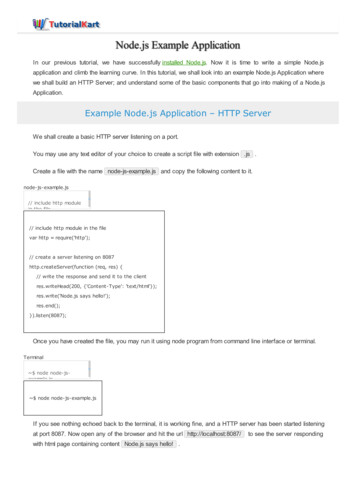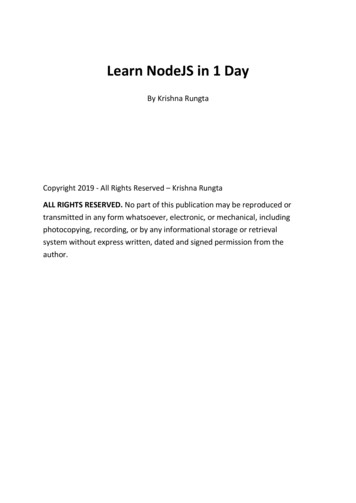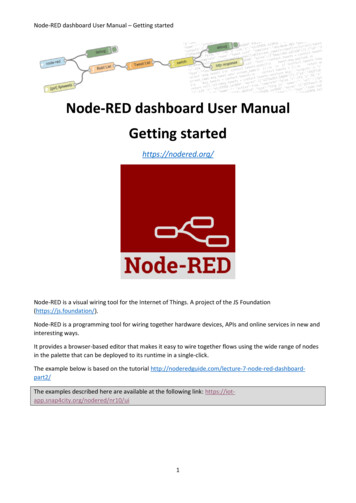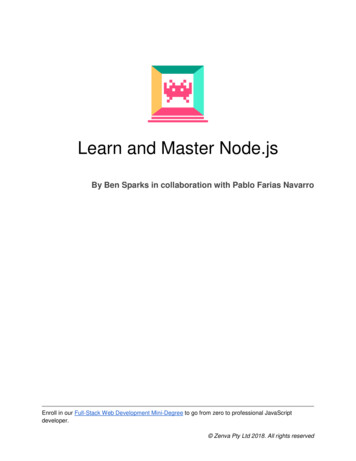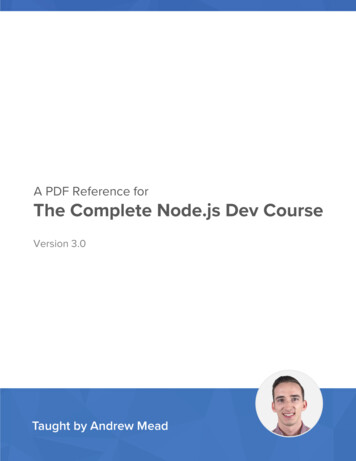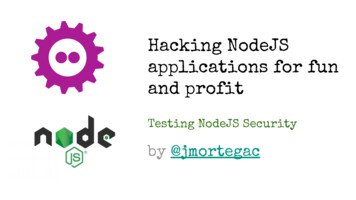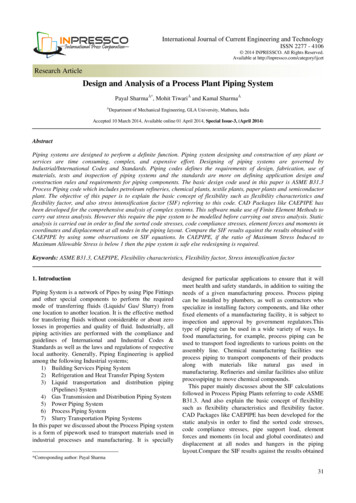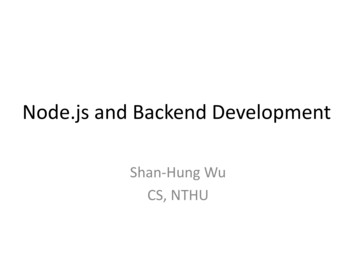
Transcription
Node.js and Backend DevelopmentShan-Hung WuCS, NTHU
Outline Node.js– Events and asynchronous I/O– NPM and CLI tools– Debugging Backend Development using Express– RESTful API– Express: routers and middleware– Testing and debugging with Postman Deployment– Cloud computing and Docker– Amazon Elastic Beanstalk2
Outline Node.js– Events and asynchronous I/O– NPM and CLI tools– Debugging Backend Development using Express– RESTful API– Express: routers and middleware– Testing and debugging with Postman Deployment– Cloud computing and Docker– Amazon Elastic Beanstalk3
Clone hello-node npm install --save yargs Yargs– Command line interface (CLI) tools Usage: node src/main.js command [options]4
Javscript runtime engine Why Node.js in the backend?– Event-based and asynchronous I/O; very fast– NPM and large ecosystem5
Node Runtime node app.js node// REPL Global objects:– window global (scope)– document process (.env, .argv(), .exit()etc.)– os, fs, module.exports Node.js supports ES6– No need for Babel– No import (use require() instead) See API Docs6
Outline Node.js– Events and asynchronous I/O– NPM and CLI tools– Debugging Backend Development using Express– RESTful API– Express: routers and middleware– Testing and debugging with Postman Deployment– Cloud computing and Docker– Amazon Elastic Beanstalk7
WeatherMood Postson Node.jsWhy fast as an backend engine?8
Asynchronous I/O// A.js.// 1fs.readReadFile('file.name', (err, data) {. // 3});// 2http.get('url', res {Time. // 5});// 4CPU A1 A6A5A3.// 6I/O 1 Shortens exectime– If with parallelI/O channelsAsyncA2I/O 2SyncA4TimeCPU A1I/O 1I/O 2A5 A6A3A2A49
Single-Threaded Event Loop// User A.js.// 1fs.readReadFile(., () {. // 3});// 2http.get(., () {. // 5});// 4.// 6// User B.js.// 1fs.readReadFile(., () {. // 3});// 2http.get(., () {. // 5});// 4.// 6CPU A1I/O 1I/O 2Process10
Single-Threaded Event Loop// A.js.// 1fs.readReadFile(., () {. // 3});// 2http.get(., () {. // 5});// 4.// 6// B.js.// 1fs.readReadFile(., () {. // 3});// 2http.get(., () {. // 5});// 4.// 6CPU A1I/O 1A2I/O 2Process11
Single-Threaded Event Loop// A.js.// 1fs.readReadFile(., () {. // 3});// 2http.get(., () {. // 5});// 4.// 6// B.js.// 1fs.readReadFile(., () {. // 3});// 2http.get(., () {. // 5});// 4.// 6CPU A1I/O 1I/O 2ProcessA2A412
Single-Threaded Event Loop// A.js.// 1fs.readReadFile(., () {. // 3});// 2http.get(., () {. // 5});// 4.// 6// B.js.// 1fs.readReadFile(., () {. // 3});// 2http.get(., () {. // 5});// 4.// 6CPU A1 A6I/O 1I/O 2ProcessA2A413
Single-Threaded Event Loop// A.js.// 1fs.readReadFile(., () {. // 3});// 2http.get(., () {. // 5});// 4.// 6CPU A1 A6I/O 1I/O 2Process// B.js.// 1fs.readReadFile(., () {. // 3});// 2http.get(., () {. // 5});// 4.// 6B1A2A414
Single-Threaded Event Loop// A.js.// 1fs.readReadFile(., () {. // 3});// 2http.get(., () {. // 5});// 4.// 6CPU A1 A6A3I/O 1I/O 2Process// B.js.// 1fs.readReadFile(., () {. // 3});// 2http.get(., () {. // 5});// 4.// 6B1A2A415
Single-Threaded Event Loop// A.js.// 1fs.readReadFile(., () {. // 3});// 2http.get(., () {. // 5});// 4.// 6CPU A1 A6A3I/O 1I/O 2Process// B.js.// 1fs.readReadFile(., () {. // 3});// 2http.get(., () {. // 5});// 4.// 6B1A2B2A416
Single-Threaded Event Loop// A.js.// 1fs.readReadFile(., () {. // 3});// 2http.get(., () {. // 5});// 4.// 6CPU A1 A6A3I/O 1I/O 2Process// B.js.// 1fs.readReadFile(., () {. // 3});// 2http.get(., () {. // 5});// 4.// 6B1A2B2A4B417
Single-Threaded Event Loop// A.js.// 1fs.readReadFile(., () {. // 3});// 2http.get(., () {. // 5});// 4.// 6CPU A1 A6A3I/O 1I/O 2Process// B.js.// 1fs.readReadFile(., () {. // 3});// 2http.get(., () {. // 5});// 4.// 6B1A2B6B2A4B418
Single-Threaded Event Loop// A.js.// 1fs.readReadFile(., () {. // 3});// 2http.get(., () {. // 5});// 4.// 6CPU A1 A6I/O 1I/O 2Process// B.js.// 1fs.readReadFile(., () {. // 3});// 2http.get(., () {. // 5});// 4.// 6B1A2B6A3B2A4B419
Single-Threaded Event Loop// A.js.// 1fs.readReadFile(., () {. // 3});// 2http.get(., () {. // 5});// 4.// 6CPU A1 A6A5I/O 1I/O 2Process// B.js.// 1fs.readReadFile(., () {. // 3});// 2http.get(., () {. // 5});// 4.// 6B1A2B6A3B2A4B420
Single-Threaded Event Loop// A.js.// 1fs.readReadFile(., () {. // 3});// 2http.get(., () {. // 5});// 4.// 6B3A5CPU A1 A6I/O 1I/O 2Process// B.js.// 1fs.readReadFile(., () {. // 3});// 2http.get(., () {. // 5});// 4.// 6B1A2B6A3B2A4B421
Single-Threaded Event Loop// A.js.// 1fs.readReadFile(., () {. // 3});// 2http.get(., () {. // 5});// 4.// 6CPU A1 A6B3I/O 1I/O 2Process// B.js.// 1fs.readReadFile(., () {. // 3});// 2http.get(., () {. // 5});// 4.// 6B1A2B6A3A5B2A4B422
Single-Threaded Event Loop// A.js.// 1fs.readReadFile(., () {. // 3});// 2http.get(., () {. // 5});// 4.// 6CPU A1 A6I/O 1I/O 2Process// B.js.// 1fs.readReadFile(., () {. // 3});// 2http.get(., () {. // 5});// 4.// 6B1A2B6A3A5B3B2A4B423
Single-Threaded Event Loop// A.js.// 1fs.readReadFile(., () {. // 3});// 2http.get(., () {. // 5});// 4.// 6CPU A1 A6I/O 1I/O 2Process// B.js.// 1fs.readReadFile(., () {. // 3});// 2http.get(., () {. // 5});// 4.// 6B1A2B6A3A5B3B5B2A4B424
CPU A1 A6I/O 1I/O 2B1A2B6A3A5B5AdvantagesB2A4B3B4 Interleaved exec of multiple code blocks Short response time Pipelining between CPU and I/Os– High throughput Avoids overhead of concurrency control (e.g.,locks, thread scheduling, etc.)– Higher throughput than muti-threaded engines25
Multi-Core Machines? Cluster module that runs one Node.js processper core Scales up linearly, if– Workload can be partitioned evenly by processes– I/Os are not saturated26
When Not to Use Node.js? CPU-bound tasksCPU A1I/O 1I/O 2A6A2B1B6A3A5B3B5B2A4B4 Or, use child process.exec() (orspawn() for streaming output from child)– Foreground core background cores27
Outline Node.js– Events and asynchronous I/O– NPM and CLI tools– Debugging Backend Development using Express– RESTful API– Express: routers and middleware– Testing and debugging with Postman Deployment– Cloud computing and Docker– Amazon Elastic Beanstalk28
NPM Package manager npm init npm install --[save save-dev] pkg-name var m require('module'); Packages vs. modules?29
--save vs. --save-dev? Given dependency tree:Your proj Pkg 1 Pkg PkgPkg 2 Pkg PkgPkg 1Pkg 23435 People who clone/fork your package willdownload the following packages:{Pkg 1, Pkg 2, Pkg 3}// via 'npm install'30
Command Line Interface (CLI) Option 1: to parse process.argv yourself Option 2: yargs.argv npm install --save yargs– Defines commands and their options– Help– Sanity checks31
Outline Node.js– Events and asynchronous I/O– NPM and CLI tools– Debugging Backend Development using Express– RESTful API– Express: routers and middleware– Testing and debugging with Postman Deployment– Cloud computing and Docker– Amazon Elastic Beanstalk32
Debugging// in srcdebugger; nodedebug debug debug debug src/main.js command [options]ncrepl Chrome inspector equivalent?33
Node Inspector (Experimental) node --inspect --debug-brk src/main.js . Then paste “chrome-devtools://.” intoChrome34
Outline Node.js– Events and asynchronous I/O– NPM and CLI tools– Debugging Backend Development using Express– RESTful API– Express: routers and middleware– Testing and debugging with Postman Deployment– Cloud computing and Docker– Amazon Elastic Beanstalk35
Node.js as Backend Engine Typically, web workloads are I/O bound– High throughput– Low latency If designed well, API requests can be easilypartitioned across multiple processes– Scales linearly36
Clone weathermood-server Checkout the file branch npm install --save express body-parser npm install –save-dev nodemon Express– A web app framework based on Node.js Body-Parser– An Express middleware for parsing request body Nodemon– Auto-restarter (remember “webpack -w”?)37
Web App Backend Development1. Prepare static resources– E.g., *.html, *.css, client-side JS, images, etc.– In dist/ of branch server-file ofweathermood2. Define API for AJAX calls– Dynamic resources, i.e., API for AJAX calls3. Code API4. Deploy web app to hosting server(s)– Web App web server(s)– For now, local machine as development server38
Outline Node.js– Events and asynchronous I/O– NPM and CLI tools– Debugging Backend Development using Express– RESTful API– Express: routers and middleware– Testing and debugging with Postman Deployment– Cloud computing and Docker– Amazon Elastic Beanstalk39
Defining APIs E.g., listing posts, create a post, vote, etc. But HTTP defines only 4 methods– GET, POST, PUT, DELETE Option 1: define new “verbs”– Always POST to the same URL– Define body (can follow SOAP) Option 2: define new “nouns”– E.g., vote POST vote– Different URLs for different nouns/resources– REST makes your backend simple and scalable40
URL MappingsURLs\MethodsGETPOSTPUTDELETEReplace the entirecollection.Delete theentirecollection.Treat this resource as Update thisa collection andresource or createcreate a new member. one (known ID).Delete thisresource.http:// {host}/ {resource}sList all resources Create a new(satisfying query resource (unknown“?.”).ID).http:// {host}/ {resource}s/ {id}Read a specificresource. Each resource type maps to 2 URL types– Collection URLs vs resource URLs List post:GET /posts?seatchText .&. Create post: POST /posts Vote “clear”: POST /posts/ {id}/clearVotes41
HTTP Response Codes GET:– 200 OK (with body) POST:– 200 OK (with body)– 201 Created (with header Location showing ID)– 204 No Content PUT and DELETE:– 200 OK (with body)– 204 No Content Error:– 400 Bad Request, 401 Unauthorized, 404 Not Found, or500 Internal Server Error42
Requirements Stateless: session state (e.g., shopping cart)cannot be kept in client side– Session state sent with requests using cookies– So, requests from clients can be partitioned easily(scalable web servers) GET requests much have no side effect– Allows proxy nodes in the routing path PUT and DELETE requests must beidempotent: duplicated requests has no effect43
Outline Node.js– Events and asynchronous I/O– NPM and CLI tools– Debugging Backend Development using Express– RESTful API– Express: routers and middleware– Testing and debugging with Postman Deployment– Cloud computing and Docker– Amazon Elastic Beanstalk44
Express Normal flow: routers model calls– Request parsing: req.query, req.params,req.body– Responses: res.status(), res.json(),res.sendStatus() Error flow: throw error handlermiddleware responses45
Middleware Error handlingServing static filesFilteringLoggingValidationAuthentication and authorizationand more.46
Outline Node.js– Events and asynchronous I/O– NPM and CLI tools– Debugging Backend Development using Express– RESTful API– Express: routers and middleware– Testing and debugging with Postman Deployment– Cloud computing and Docker– Amazon Elastic Beanstalk47
Debugging Nodemon: npm run watch Postman48
Outline Node.js– Events and asynchronous I/O– NPM and CLI tools– Debugging Backend Development using Express– RESTful API– Express: routers and middleware– Testing and debugging with Postman Deployment– Cloud computing and Docker– Amazon Elastic Beanstalk49
Cloud Computing Not only services Also platformsor infrastructure– Pay only whatyou used50
IaaS, PaaS, and SaaS51
Web App Backend:PaaS or IaaS?52
Development Efficiency Iterations: bug fixes, updates, finding PMF, etc. Time is money! IaaS: high management cost, low elastisity PaaS: low cost and elastic, but“Well, it works on my computer ”
Outline Node.js– Events and asynchronous I/O– NPM and CLI tools– Debugging Backend Development using Express– RESTful API– Express: routers and middleware– Testing and debugging with Postman Deployment– Cloud computing and Docker– Amazon Elastic Beanstalk54
PaaS You define your runtime55
Virtual Machines vs. Containers Lightweight, elastic Consistent runtime56
“Dockerizing” an App1. Build a Docker Image2. Upload the image to targeted server(s)3. Launch container from image57
Example: Local Development Server Install Docker Community Edition first// in project folder vim Dockerfile vim .dockerignore docker build -t name:tag . docker images dockerdockerdockerdockerrun -p 80:8080 -d image stop restart container ps [-a]system prune58
Watch out Data Loss! Modifications to filesystem are local to acontainer– Gone if container deleted If necessary, use data volumes to persists dataacross containers– Basically, specially-designated directories59
Beyond development server?60
Outline Node.js– Events and asynchronous I/O– NPM and CLI tools– Debugging Backend Development using Express– RESTful API– Express: routers and middleware– Testing and debugging with Postman Deployment– Cloud computing and Docker– Amazon Elastic Beanstalk61
User RequestsCDNRoute BalancerStorageLoad Balancer (L3-7)Reverse Proxy (L7)Web Server Cluster“Typical”Environment DDoS protection Static vs. dynamicresources High availability LB, caching,acceleration (SSL), etc. Auto-scaling groups Scale up vs. out Slave DBMS can serveread-only requestsMem. CacheM DBMSAvail. Zone (AZ)SAvail. Zone62
SolutionsNodeAmazon (AWS)AlternativesRoute BalancerRoute 53CloudflareCDNCloudFrontCloudflare, Google Cloud CDNStorageSimple Storage Service (S3)HDFSLoad BalancerElastic Load Balancing (ELB)NginxReverse ProxyNginxWeb ServerElastic Compute Cloud (EC2)HerokuMem. CacheElastiCacheRedis, MemcachedDBMSRelational DB Service (RDS)PostgreSQL, MySQL, MongoDB Web app on EC2 (with Docker and Nginx preinstalled) But what about the rests?63
AWS Elastic Beanstalk Single AZ by default64
Staging Environment65
Instructions1. Create an AWS account– Free-tier for the first year, and free credits from AWS Educate– Credit card needed (one per group); no immediate charge2. Install Elastic Beanstalk CLI– Install Python runtime (e.g., Aanaconda) first pip install --upgrade awsebcli eb –version// in project folder eb init // create eb application eb create [--single] // create environment eb terminate env // upates git commit eb deploy env // deploys the latest commit eb use env // env for current branch66
User Requests“Typical”Environment Add AZs easily in console How to enableCDN?67
Cache Control CloudFront and client browsers use CacheControl response header to cache static files// in server.jsapp.use(express.static('dist', {maxAge: . // in ms. For client browsers and proxies})); Be careful about file versioning// orapp.use(express.static('dist', {setHeaders: (res, path, stat) {// in seconds. For proxies onlyres.set('Cache-Control', 'public, s-maxage .');}}));68
Readings (Optional) HTTPS– Production environments– Staging environments Custom domain names69
Worker Environments For CPU-bound tasks (e.g., data analytics)70
Assignment: TODOsRESTful APIServer-side routers, model, etc.Client-side AJAX callsAWS Deployment (one per group)71
Node.js –Events and asynchronous I/O –NPM and CLI tools –Debugging Backend Development using Express –RESTful API –Express: routers and middleware –Testing and debugging with Postman Deployment –Cloud computing and Docker –Amaz
